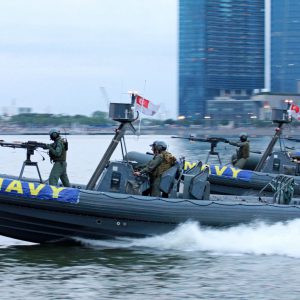National Service and Citizen Soldiers – The Singapore Experience of Military Conscription
March 15, 2021

The National Service (Amendment) Bill was passed on 14th March 1967 and made it compulsory for all 18-year-old male Singaporean citizens and permanent residents to undergo two years of military service. Though modified and modernised in recent years, the bill has retained its original focus and intent over the following half century – to protect the city-state and its people from any foreign threat.
To outside observers, National Service (NS) in Singapore, first introduced by the British in 1954 and made mandatory by the PAP government in 1967, might appear anachronistic and contradictory to the modern vision of the city state as a peaceful, financial, and technology centred entrepot.
However, the political and military realities of the fledging nation state in 1965, left with only a nominal infantry force to serve as national security against the potential threats of Indonesian Konfrontasi and Malaysian revanchism, necessitated the creation of a loyal and reliable national armed forces.
Associate Professor Albert Lau (NUS Department of History) in ‘National Service and Citizen Soldiers – The Singapore Experience of Military Conscription’ (National Service in Singapore, 2019) surveys the historical evolution and administration of NS in Singapore between 1954 and 2017. The text shows how inspiration and guidance was sought from the highly effective Israeli Defence Forces on how to train the first generation of NS recruits, but that thereafter the basic composition of NS has remained more or less unchanged since its inception; with all Singaporean adult males required to serve two to three years with the army, and a further 10 years in the reserves until age 40.
Universality and equity are considered the crucial underpinnings of why NS continues to maintain such a positive sentiment among Singaporeans up to the present day. There are no grounds for exemption, and the text highlights the intense scrutiny of the ‘white horse’ category (NS-liable sons of influential figures); these young men are strictly mandated to see out the whole term of NS – to assure the public that NS is fair across the board, no matter the family background or political connections.
A/P Lau details how in the past two decades, however, certain adjustments have been made to modernise the programme in order to better reflect Singapore in the 21st century. For example, in 2004 the first major change to NS was enacted with the conscription period reduced from two and a half years to two years. In addition, the adjustment included greater transparency for worried parents of conscripts, such as inviting parents to accompany their sons directly to camp to see what life in NS would really be like.
As Minister for Defence Dr Ng Eng Hean asserted in 2017, ‘We can never change the fact that we are a small country, but today, after 50 years of NS, we have built an SAF capable of defending Singapore.’ From a small force of two infantry battalions in 1965, the Singapore Armed Forces now possesses a force of 72,500 active servicemen and 312,500 trained men in the reserves.
Read the full article here.
